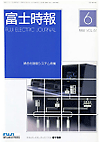FUJI ELECTRIC JOURNAL Vol.61-No.6 (Jun/1988)
 |
|
Concept of Fuji Electric's Integrated Control System
Hiraki Kawakami,, Sadao Kambara
Fuji Electric has continued developing integrated distributed control systems for a long time. Recently, the views that the electric control system (E), instrumentation system (I), and computer control system (C) should be integrated has been roused mainly by the development of microcomputers. The company has structured a new integrated EIC control system based on the former distributed and integrated systems to meet the trends.
This paper describes the background of the development, i.e. industrial requirements and technical trends, and Fuji Electric's activities for the integrated control system together with forecasting future systems.
This paper describes the background of the development, i.e. industrial requirements and technical trends, and Fuji Electric's activities for the integrated control system together with forecasting future systems.
Fuji Electric's Integrated Control Systems
Tsuneaki Yokoyama, Hidenori Sugiura
This paper introduces the concept, the outline and objectives of integration, etc. of Fuji Electric's integrated distributed control system. It firstly describes the system of distribution, function sharing, and concept of integration; secondly, the actual system configuration and outline of integrated functions, in the points of networks, MMI devices, component standardization, data management, and support functions, together with the concept of Fuji Electric's systems; further, it reviews the objectives and precautions from the viewpoints of improvement in function and performance, operation and monitoring, maintenance and expandability, and reliability.
Hardware of Integrated Control Systems
Hiroaki Nojiri, Souji Shirako, Tetsuo Ishikawa
Aiming at high-efficiency control systems, Fuji Electric has proceeded to structure the control systems which integrate electric control, instrumentation, and computer control.
The points of the integration consist mainly in structuring functions by software technology, such as the common data structure, unified man-machine operation concept, and integrated programming procedure; however, the unified architecture of components and stsndardization of networks are important items from the side of hardware. This paper describes the technical points and actual products of the hardware which configures the control systems.
The points of the integration consist mainly in structuring functions by software technology, such as the common data structure, unified man-machine operation concept, and integrated programming procedure; however, the unified architecture of components and stsndardization of networks are important items from the side of hardware. This paper describes the technical points and actual products of the hardware which configures the control systems.
Software of Integrated Control Systems
Tsuneaki Yokoyama, Masakiyo Ohshiba
This paper first describes the general consideration of distributed control system software from the points of function structure, information structure, and overall system management, and Fuji Electric's policy adopted to cope with it. Next, it refers to the fundamental software structure in distributed systems and sorts out the problems. Further, it gives a description of the basic view on Fuji Electric's integrated control systems realized in the integrated data management (FSINET), integrated MMI devices, and integrated service supporting software development (FAISES). Lastly it touches on the future development plan.
Networks for Integrated Control Systems
Tadao Enokidani, Masayuki Tanimoto, Ken Kakizakai
The importance of open-system architecture providing multi-vendor environment has been recognized in the network systems in the industrial field, and the international activities for standardization are positively promoted mainly by ISO and IEC to meet these needs. This paper introduces the movements for standardization of OSI, MAP, TCP/IP, and the field bus. It refers to the outline of Fuji Electric's networks in integrated control systems and its plan for open systems in line with the movements.
Data Management for Integrated Control Systems
Masaki Nonaka, Keizo Murakami
The trend of plant control systems is toward distributed processing which enables stepwise structuring dangerdecentralized systems. In case that distributed components are combined, the proportion of the cost for connection between components, operation, and maintenance to the whole system cost is increasing by year. Top-down integration technology is effective to solve this problem, and in-between network protocol and unified data management take a leading part here. The paper introduces an outline of integrated data management software (FSINET) in connection with the abovementioned technology.
Man-Machine Interface Devices in Integrated Control Systems
Haruki Hagiwara, Hukashi Koyama, Masakazu IKoma
Recent development and spread of microcomputers have given important impact to the architecture of plant control systems. Especially, former man-machine interface (MMI) devices applied to each field of electric control (E), instrumentation (I), and computer control (C), but the rapid technical development of microprocessors urged revision of technical boundaries and appearance of integrated man-machine systems to meet cost reduction. This paper describes the technical items required for EIC-integrated MMI devices and their present states.
Support Systems for Integrated Control Systems
Hiroshi Kawahara, Yuhei Tanaka
The times when the support system for process control systems supported only a field, a section, or a device have been over, and now it realizes integrated support for whole systems. As the proportion of software cost increased, the importance of support systems has become greater. The paper introduces an engineering support package FAISES for DCS integrated system which can run on personal computers and application oriented support system CATS, and FRENDS placing the CASE system at the core which was developed for rationalising engineering in the firm to cope with CIM application.
Functional Intermediate Language for Integrated Software Production
Haruki Tanaka, Yutaka Yoshida, Kazumasa Kodaira
As control software becomes larger in scale and more sophisticated, it is more important to produce high-quality software industrially. For this purpose, a unified base language is indispensable to integrate software to enable industrial approach with unified base language, Fuji Electric has developed a functional intermediate language FCL for integrating software. The paper introduces the role of FCL in control software integration, its design philosophy, and an example of software production systems with the FCL as a base language.

